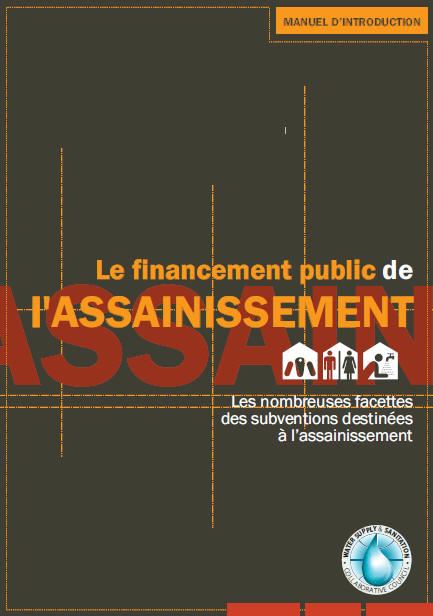Le Financement Public de l'Assainissement: les nombreuses facettes des subventions destinées à l'assainissement
 |
Public Funding for Sanitation. The many faces of sanitation subsidies
rapport Oct 2009 ; 44 pages
Aut. Barbara Evans & Andy Peal & Carolien van der Voorden
Ed. WSSCC - Genève
Téléchargeable sous format: PdF
Téléchargeable chez l'éditeur
Page de présentation d'un éditeur
Résumé:
Ce manuel a pour objectif d'aider le lecteur à comprendre le débat mondial sur les subventions et le financement de l'assainissement et de fournir des conseils sur la manière de sélectionner les systèmes de financement les plus appropriés dans différentes situations. Aussi, il vise à clarifier la terminologie et le langage utilisés dans le débat sur le financement public de l'assainissement et des subventions en particulier. Enfin, il permet d'aider les membres des coalitions nationales WASH du Conseil de concertation pour l'approvisionnement en eau et l'assainissement (WSSCC) et leurs partenaires dans leurs discussions sur les mécanismes de financement. Abstract:
This primer assists the reader in understanding the global debate on subsidies and sanitation financing, and provides guidance on how to select the most appropriate funding arrangements for sanitation programming in different situations. Sommaire:
Le manuel d'introduction est composé de cinq parties principales:
La 1ère Partie, « Comment fonctionne le financement public de l'assainissement ? »
Contents:
Part 1, ‘How does Public Funding of Sanitation Work?’, discusses what needs to be financed and the sources of financing for sanitation programmes as a whole, introducing the concepts and principles by which public funds can be allocated.
Part 2, ‘The Debate on Sanitation Subsidies’, summarizes the main arguments ‘for’ and ‘against’ subsidies (particularly hardware subsidies), before offering details on the general principles which can promote good financial design of sanitation programmes.
Part 3, ‘Types of Subsidies’, looks at the financing available for software activities. The ten types of hardware subsidies commonly used and examples of their application are detailed with insights into their advantages and disadvantages.
Part 4, ‘Smart Financing of Sanitation Systems’, takes four generic sanitation systems and their technical options to explore what the real-life options for financing both their capital and operational costs are, considering private, public and blended financing in each case.
Mots clefs: |
assainissement (CI) (DT) (OP) (ope) , financement (CI) (DT) (OP) (ope) |
Editeur/Diffuseur: |
|
WSSCC
-
Water Supply and Sanitation Collaborative Council - Genève - Suisse |
En cas de lien brisé, nous le mentionner à communication@pseau.org